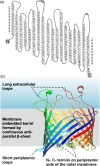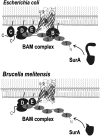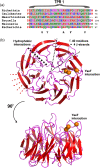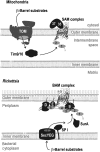Protein secretion and outer membrane assembly in Alphaproteobacteria
- PMID: 18759741
- PMCID: PMC2635482
- DOI: 10.1111/j.1574-6976.2008.00130.x
Protein secretion and outer membrane assembly in Alphaproteobacteria
Abstract
The assembly of beta-barrel proteins into membranes is a fundamental process that is essential in Gram-negative bacteria, mitochondria and plastids. Our understanding of the mechanism of beta-barrel assembly is progressing from studies carried out in Escherichia coli and Neisseria meningitidis. Comparative sequence analysis suggests that while many components mediating beta-barrel protein assembly are conserved in all groups of bacteria with outer membranes, some components are notably absent. The Alphaproteobacteria in particular seem prone to gene loss and show the presence or absence of specific components mediating the assembly of beta-barrels: some components of the pathway appear to be missing from whole groups of bacteria (e.g. Skp, YfgL and NlpB), other proteins are conserved but are missing characteristic domains (e.g. SurA). This comparative analysis is also revealing important structural signatures that are vague unless multiple members from a protein family are considered as a group (e.g. tetratricopeptide repeat (TPR) motifs in YfiO, beta-propeller signatures in YfgL). Given that the process of the beta-barrel assembly is conserved, analysis of outer membrane biogenesis in Alphaproteobacteria, the bacterial group that gave rise to mitochondria, also promises insight into the assembly of beta-barrel proteins in eukaryotes.
Figures





Similar articles
-
Conserved residues of the putative L6 loop of Escherichia coli BamA play a critical role in the assembly of β-barrel outer membrane proteins, including that of BamA itself.J Bacteriol. 2012 Sep;194(17):4662-8. doi: 10.1128/JB.00825-12. Epub 2012 Jun 29. J Bacteriol. 2012. PMID: 22753067 Free PMC article.
-
YfiO stabilizes the YaeT complex and is essential for outer membrane protein assembly in Escherichia coli.Mol Microbiol. 2006 Jul;61(1):151-64. doi: 10.1111/j.1365-2958.2006.05211.x. Mol Microbiol. 2006. PMID: 16824102
-
A Supercomplex Spanning the Inner and Outer Membranes Mediates the Biogenesis of β-Barrel Outer Membrane Proteins in Bacteria.J Biol Chem. 2016 Aug 5;291(32):16720-9. doi: 10.1074/jbc.M115.710715. Epub 2016 Jun 13. J Biol Chem. 2016. PMID: 27298319 Free PMC article.
-
Assembly of β-barrel proteins into bacterial outer membranes.Biochim Biophys Acta. 2014 Aug;1843(8):1542-50. doi: 10.1016/j.bbamcr.2013.10.009. Epub 2013 Oct 14. Biochim Biophys Acta. 2014. PMID: 24135059 Review.
-
Molecular mechanism of ferricsiderophore passage through the outer membrane receptor proteins of Escherichia coli.Biometals. 2007 Jun;20(3-4):263-74. doi: 10.1007/s10534-006-9060-9. Epub 2006 Dec 22. Biometals. 2007. PMID: 17186377 Review.
Cited by
-
Characterization of the β-barrel assembly machine accessory lipoproteins from Borrelia burgdorferi.BMC Microbiol. 2015 Mar 24;15:70. doi: 10.1186/s12866-015-0411-y. BMC Microbiol. 2015. PMID: 25887384 Free PMC article.
-
Evolution of macromolecular import pathways in mitochondria, hydrogenosomes and mitosomes.Philos Trans R Soc Lond B Biol Sci. 2010 Mar 12;365(1541):799-817. doi: 10.1098/rstb.2009.0167. Philos Trans R Soc Lond B Biol Sci. 2010. PMID: 20124346 Free PMC article. Review.
-
The minimal proteome in the reduced mitochondrion of the parasitic protist Giardia intestinalis.PLoS One. 2011 Feb 24;6(2):e17285. doi: 10.1371/journal.pone.0017285. PLoS One. 2011. PMID: 21390322 Free PMC article.
-
β-Barrel Assembly Machinery (BAM) Complex as Novel Antibacterial Drug Target.Molecules. 2023 Apr 27;28(9):3758. doi: 10.3390/molecules28093758. Molecules. 2023. PMID: 37175168 Free PMC article. Review.
-
Crystal structure of BamD: an essential component of the β-Barrel assembly machinery of gram-negative bacteria.J Mol Biol. 2011 Jun 10;409(3):348-57. doi: 10.1016/j.jmb.2011.03.035. Epub 2011 Apr 2. J Mol Biol. 2011. PMID: 21463635 Free PMC article.
References
-
- Alcock FH, Grossmann JG, Gentle IE, Likić VA, Lithgow T, Tokatlidis K. Conserved substrate binding by chaperones in the bacterial periplasm and the mitochondrial intermembrane space. Biochem J. 2008;409:377–387. - PubMed
-
- Andersson SG, Kurland CG. Reductive evolution of resident genomes. Trends Microbiol. 1998;6:263–268. - PubMed
-
- Baars L, Ytterberg AJ, Drew D, Wagner S, Thilo C, van Wijk KJ, de Gier JW. Defining the role of the Escherichia coli chaperone SecB using comparative proteomics. J Biol Chem. 2006;281:10024–10034. - PubMed
Publication types
MeSH terms
Substances
Grants and funding
LinkOut - more resources
Full Text Sources
Molecular Biology Databases

